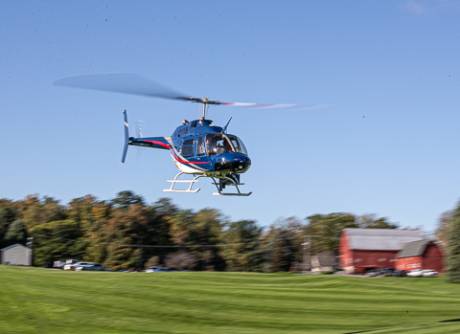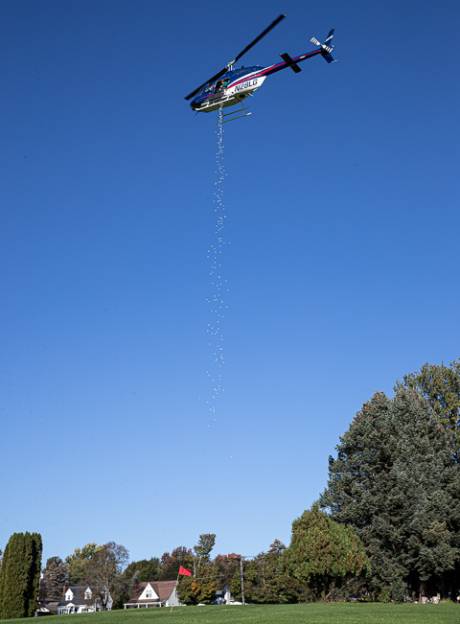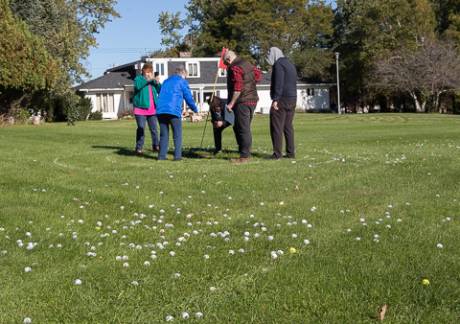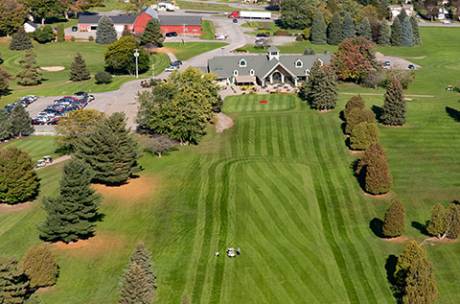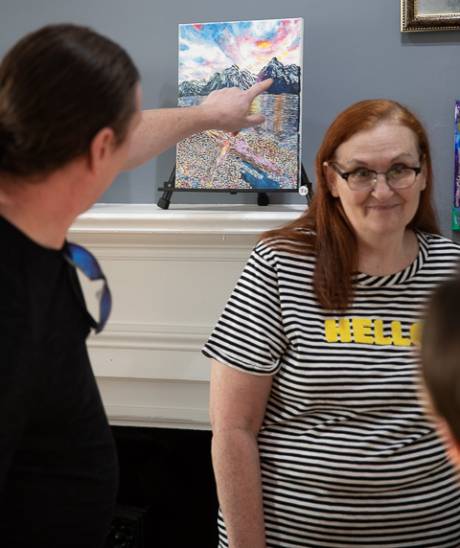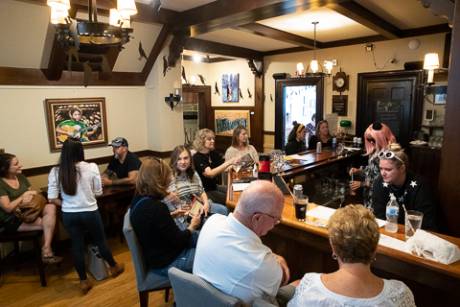Next week, Hollywood comes to Batavia.
GoArt!, in partnership with local author Bill Kauffman -- author of such books as "Dispatches from the Muckdog Gazette" and "Look Homeward America" -- and filmmaker Ronald F. Maxwell -- director of the Civil War epics "Gettysburg" and "Gods and Generals" -- will host a screening of the movie "Copperhead" on Thursday, June 13.
This will give locals a chance to see the film before its official release in theaters on June 28.
"Copperhead" takes place in Upstate New York during the Civil War. Kauffman wrote the screenplay, based the novel "The Copperhead" by Harold Frederic, and Maxwell directed it.
Both men will be at the screening, and the movie will be followed by a short presentation by Kauffman and a Q&A session with Kauffman and Maxwell.
In anticipation of the screening, they spoke with The Batavian about the project itself, their collaboration over the years, among other things.
(To Ron): I understand you have been a longtime fan of Bill Kauffman. So this is a two-part question:
A. When and how did you first discover his work?
B. When and how did you two come into contact?
Ron: Actually the second thing happened first. We both attended an event in Washington, D.C. --- at which he spoke -- sometime in the mid-1990s. I was impressed with his wit, with his use of language, his sense of humor, and his insight, and that started a long friendship. I subsequently read his writings, and we stayed in touch over the years.
Bill: “Copperhead” was actually my second screenplay. The first one was a project that Ron and I started developing several years ago. This was also an historical film, and it almost made it into development but didn't. We still hope it will someday. So "Copperhead" was my second screenplay, but it was the first to be produced.
(To both): What drew you to this material?
Bill: I probably first read the book 25 or more years ago. Harold Frederic was one of the great Upstate New York novelists. In fact his most well-known book, "The Damnation of Theron Ware," was hailed by F. Scott Fitzgerald as the best American novel before 1920.
Edmund Wilson, the great literary critic, praised Frederic's "Civil War Stories" for being unlike any other Civil War fiction. There's no Southern "moonlight and magnolias" romanticism, and there's no Northern "Battle Hymn of the Republic" righteousness; these are hard, unsentimental but very poignant stories of life in the North -- specifically Upstate New York -- on the home front during the war...the people left behind.
And this particular story, "The Copperhead," is about a farmer, a respected man, in a little hamlet in Upstate New York -- he's an old-fashioned Democrat who is against the war. And he is standing up, really, against his community on this. The community is torn apart, his family and the family of his chief rival are torn apart. So these people are casualties of the war in a different way.
The film is also, I think, about the resilience and resourcefulness of the people at home during wartime. It's a rich and complex story about our area, for one, and also about a fascinating time in American history.
Ron: As soon as I read it I thought, "Wow, this would be a terrific subject for a film." And I kind of ruminated for a while until about three and a half years ago, when it came up in conversation with Bill over dinner in Connecticut. I think he mentioned it first, but we both knew the novel and admired it. It was very interesting to me to explore the whole issue of the dissenters in society -- especially within the context of the Civil War, because I had already explored the reasons why good men chose to go to war in the other films, whether they wore blue or gray. Here was a film where you could explore why a good, ethical man chose not to go to war. It's the other side of the coin.
(To Bill): How was the screenwriting process different from the process of writing a book?
Bill: It’s a whole different style of writing. Writing a book is very much a solitary endeavor, although there is give-and-take with the editor. Movies are totally collaborative ventures. Even with the screenplay, Ron and I consulted throughout. Ron has a great sense for how to tell a story. So it was a very harmonious collaboration -- he's a great guy, and we work well together.
(To Ron): You wrote the scripts for both "Gettysburg" and "Gods and Generals." Why did you choose to have Bill write this one?
Ron: Well, as I said, it came up over a dinner, and by that time he and I had collaborated on the earlier project that he wrote. So I knew that he could do it. And I think part of the dynamic there is that when you write a screenplay, you need to focus big time and stop doing everything else. At the time we started to talk about "Copperhead," I was totally immersed in something else, so I could not write the screenplay myself even if I wanted to. But I knew he could. So I worked with him, you know, in the way that a director-filmmaker works with a writer. We closely collaborated on it, but he in fact did the writing. A lot of times in Hollywood there are shared credits when a director works with the writer, but I'm a strong believer that the writer gets the credit. Because the writer is doing the work.
So, just as on the earlier screenplay, we collaborated but Bill adapted the novel. And I knew that his sensibilities would be very responsive to it. It takes place, as you know, in Upstate New York. And Bill was not only aware of this novel, but he had read other works of Harold Frederic.
In a sense, Bill is a regionalist. He's very aware of where he lives -- not just of how it is now, but of its history and literary traditions. So he was already connected to the history of this part of the world, and to Harold Frederic specifically. So of all the writers in the world, he was probably the most perfectly adapted to work out the screenplay.
If you know Bill's other work, one of his preoccupations is small town America. He has made the choice to live in small town America because he thinks that that's where American values are embodied and where the "simpler life" can be lived. That's a theme that runs through all of his nonfiction, and is certainly one of the themes of this particular story. One of the things ("Copperhead") explores is living in a rural community. I'm sure it was much more rural, with a much smaller population, back then than it is now. But again, Bill was predisposed to understanding and exploring the values of these people.
(To Bill): Were you a fan of Ron's films before this?
Oh yeah, absolutely. He's the great cinematic interpreter of the Civil War. This is his third Civil War film, but it's on a different scale. ("Gettysburg" and "Gods and Generals") had scenes with thousands of extras colliding on the great battlefields -- they were Civil War films set behind the lines.
Were you intimidated by the prospect of writing a script for him after seeing the scope of his previous films?
Bill: Well, you know, I might have been, but we had known each other. We're friends, so in that sense it was comfortable. But it was a challenge. I like challenges, and I have over the years read a lot of screenplays in preparation for this film. I'd read a number of screenplays of films that I like very much -- everything from Paul Schrader's script for "Taxi Driver" to Graham Greene's screenplay for "The Third Man." So I had an idea of how to do it, and Ron was an invaluable guide to picking up the form and grammar of a screenplay.
(To Ron): Had you ever in your life heard of Batavia before meeting Bill?
Ron: No, and I wasn't even sure whether to say Bat-ah-via or Bat-ay-via. But I guess it's like that Cole Porter song, "You say tom-ay-to, I say tom-ah-to."
(To Bill): Are there any local connections in "Copperhead"?
Bill: There is one specifically Batavia reference -- it's a little bit of an inside joke -- early in the film. Some folks will pick up on it. But I can't tell you anymore.
Also, my daughter, Gretel, and the daughter of one of the producers have cameos in the film. It's during the barn dance scene -- look for the "giggling girls."
(To Bill): Did you have chance to visit the location shoots in Canada? If so, what was this like?
Bill: I was there for about four to seven weeks. I went up a couple different times. I got a real kick out of watching these characters that existed on paper become real. And it's funny, because some of the characters ended up looking very different from how I thought they'd look. But I think the actors really brought to life and enriched the story with their own contributions. They did a lot of studying, put a lot of thought into the roles, and I think it shows on the screen.
(On Ron as a director): You hear stories of these tyrannical, dictatorial directors, but Ron is nothing at all like that. He's very much in control, and the production is well run. But he listens to people, everyone gets along, and it's very harmonious. He does a lot of planning (before production), and that shows in that there's a real efficiency about it. It was shot over about seven weeks, and there were no wasted days. They worked from sunup to sundown. It was very impressive.
(To Bill): I understand the actors were instructed to study your Western New York accent. What was that experience like?
Bill: (Laughs) Yes, they had a dialect coach from Canada who did a great job with them. We don't have any tapes of what people in Upstate New York sounded like in 1862, so one of the things she did -- unbeknownst to me -- was send them videotapes of speeches of mine. So it was kind of fun on the set when actors would come up to me and ask, "How do you say 'apple'? How do you say 'orange'?" Of course, we're not aware of our accents. To us, we speak normally and everyone else has an accent. And when someone asks you to pronounce something, inevitably a little bit of self-consciousness creeps into you, you know? You exaggerate whatever little accent you might have. But yeah, that was a lot of fun. And fortunately, they do not all sound like me (laughs). They develop their own accents and styles of speaking.
(To Ron): Many of the actors in "Copperhead" are a bit less well-known than a lot of movie stars out there. Was this an artistic decision on your part?
Ron: Yes, very much so, insofar as you want (as a filmmaker) to be able to have the creative freedom to cast the way you want. We made a decision early on that we were not going to chase the movie stars. Because then you're always at the mercy of their schedules, their price tags, and competing for their time with the major studios. So suddenly you're not in control of your own movie. And I've played that game, so I know that game. We wanted to be independent and just cast the movie the best way we knew we could, make the movie we wanted to make, hope that it would stand on its own merits, and get it to the public.
The reason people get the big stars is because those stars will get the movie financed and distributed. It's a simple formula. So if you think you can have alternate ways of getting the movie financed and distributed, then that allows you artistic freedom.
(To both): How did the upcoming screening/fundraiser come about?
Ron: We thought, as part of our marketing and promotion of the movie, that it would behoove us to do a number of screenings across the country to help generate word of mouth and grassroots support of the film. And we thought, "What better way than to ally with charitable organizations?" So we looked for charitable organizations that we could feel comfortable supporting, and we have about 18 or 19 of these all across the country.
Bill: The producers asked me about having one of the screenings in Batavia, and I of course jumped at the chance. And I thought GoArt! would be a great organization (to support), and they were enthusiastic about sponsoring.
(To Ron): What interests you about the Civil War Era as a filmmaker?
RM: Well, you know, I was drawn to it so many years ago now...it took me 15 years from the time I read (Michael Shaara's) "The Killer Angels" (the book on which "Gettysburg" is based) until the time "Gettysburg" was released in the theaters. I didn't know it was going to take 15 years, and I certainly didn't know I would spend another 10 years making "God and Generals," and then another 10 years before I could make "Copperhead." That's a lot of years altogether -- it's a big chunk of anyone's life to spend on one historical period. It's not like I set out to do that, it just kind of happened that way.
But along the way I came to realize that it has been a deep and abiding interest. It's just endlessly fascinating, and these are stories that have been very compelling to me. I have other kinds of projects I've been working on -- I have a Western I've been working on, a project on Joan of Arc, contemporary films...I'm always juggling them and trying to get them financed like other filmmakers. But it's just kind of worked out that "Gettysburg" led to "Gods and Generals," which led to "Copperhead." A lot of that is my own focus and my own energy, but some of it is serendipitous.
(To Bill): What draws you to writing about small town America?
BK: Well, it's where I've spent most of my life -- it's where I am now. To me, Batavia was always a source of fascination. Every story you could tell was on its streets and in its buildings.
It's not that people in small towns are better than people in big cities. But I think because of the smallness and intimacy of the scale, it's a place where the individual can matter. In the anonymity of the big cities and suburbs, sometimes the individual can get lost in the crowd. To me, life in a small town seems more real, more immediate. I also think that small towns get the short shrift, both culturally and politically. It's unexplored territory.
(To both): Do you have any words of advice or encouragement for readers who might be aspiring toward successful careers in writing or filmmaking?
Bill: Words of advice for aspiring writers? I guess I'd say Read Read Read Read Read. Persevere. And don't get discouraged.
Ron: Well the most important thing is for aspiring filmmakers to develop and protect their own voice -- and not kind of mimic, copy, cater, pander or be what they think someone else wants them to be, what Hollywood wants them to be, or what any third party wants them to be. Because then they are wasting their own time and everyone else's. If they can hold onto that little voice inside them that is their unique voice, that's the most important thing. That's what we want to hear and watch.
The screening of "Copperhead" will take place at Genesee Community College's Stuart Steiner Theatre, at 1 College Road in Batavia, and start at 7 p.m. Tickets are $20 for GoArt! members and $25 for non-members.
For more information or to purchase tickets, go to www.goart.org/events.php#Copperhead or call 343-9313.
Supplemental: "Copperhead" trailer
Photo of Ronald F. Maxwell directing courtesy of George Nicholis.
